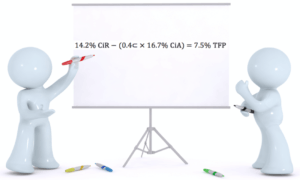Measure the increase in productivity per employee using the formula for Total Factor Productivity.
Accomplishment may be measured by the increase in productivity per employee. For many, calculating productivity has been nebulous and argumentative. Total Factor Productivity permeates industries from service and software to the manufacturing of products and goods. Since no formula of any value goes without an acronym, call it the TFP. As a calculation, TFP looks like this:
XX% CiR − (0.4 constant * XX% CiA) = TFP
Here is an explanation for Total Factor Productivity:
CiR represents the “Change in Revenue (per employee)”. If an illustrative small company or business unit with $218 million has 1,400 employees has a revenue of $155,000 per employee. If the following year they grow to 1,500 employees and realize revenue of $257 million, they will realize $171,333 per employee or a positive change of 14.2 percent.
Constant represents a baseline and 0.4 is being used, although it could be modified. Be careful, however, as MIT Professor Robert Solow received a Nobel Memorial Prize for his work. He discovered that 0.4 represents the best overall constant to use. If used by others, it also allows for direct comparison.
CiA represents the “Change in Assets (per employee)”. If our illustrative company or business unit grows its assets from $60,000 per employee to $70,000 per employee, it will realize a 16.7 percent increase in its CiA.
Therefore, using our illustrative results above, the calculation would look like this:
14.2% CiR − (0.4⊂ * 16.7% CiA) = 7.5 percent TFP
TFP now represents gains made in labor productivity, less gains from investing in capital. TFP can be driven by various factors including cost cutting, increased market share, new products, or getting something out of idle assets (e.g., vacant property). Innovation and new technology drive or propel the USA economy for increasing TFP, including hardware (e.g., GPS or geo-positioning systems equipment) and software improvements (e.g., resulting in fleet and fuel optimization).
TFP measures the revenue for each employee and also factors in capital assets and investments in equipment, information, and technology.
______
Don’t ruin your career by hosting bad meetings. Sign up for a workshop or send this to someone who should. MGRUSH workshops focus on meeting design and practice. Each person practices tools, methods, and activities every day during the week. Therefore, while some call this immersion, we call it the road to building high-value facilitation skills.
Our workshops also provide a superb way to earn up to 40 SEUs from the Scrum Alliance, 40 CDUs from IIBA, 40 Continuous Learning Points (CLPs) based on Federal Acquisition Certification Continuous Professional Learning Requirements using Training and Education activities, 40 Professional Development Units (PDUs) from SAVE International, as well as 4.0 CEUs for other professions. (See workshop and Reference Manual descriptions for details.)
Want a free 10-minute break timer? Sign up for our once-monthly newsletter HERE and receive a timer along with four other of our favorite facilitation tools, free.

Terrence Metz, president of MG RUSH Facilitation Training, was just 22-years-old and working as a Sales Engineer at Honeywell when he recognized a widespread problem—most meetings were ineffective and poorly led, wasting both time and company resources. However, he also observed meetings that worked. What set them apart? A well-prepared leader who structured the session to ensure participants contributed meaningfully and achieved clear outcomes.
Throughout his career, Metz, who earned an MBA from Kellogg (Northwestern University) experienced and also trained in various facilitation techniques. In 2004, he purchased MG RUSH where he shifted his focus toward improving established meeting designs and building a curriculum that would teach others how to lead, facilitate, and structure meetings that drive results. His expertise in training world-class facilitators led to the 2020 publication of Meetings That Get Results: A Guide to Building Better Meetings, a comprehensive resource on effectively building consensus.
Grounded in the principle that “nobody is smarter than everybody,” the book details the why, what, and how of building consensus when making decisions, planning, and solving problems. Along with a Participant’s Guide and supplemental workshops, it supports learning from foundational awareness to professional certification.
Metz’s first book, Change or Die: A Business Process Improvement Manual, tackled the challenges of process optimization. His upcoming book, Catalyst: Facilitating Innovation, focuses on meetings and workshops that don’t simply end when time runs out but conclude with actionable next steps and clear assignments—ensuring progress beyond discussions and ideas.




